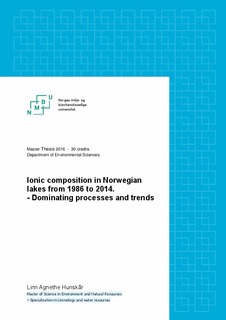| dc.contributor.advisor | Haaland, Leif Ståle | |
| dc.contributor.advisor | Riise, Gunnhild | |
| dc.contributor.author | Hunskår, Linn Agnethe | |
| dc.date.accessioned | 2016-08-11T11:17:32Z | |
| dc.date.available | 2016-08-11T11:17:32Z | |
| dc.date.issued | 2016-08-11 | |
| dc.identifier.uri | http://hdl.handle.net/11250/2398792 | |
| dc.description.abstract | In the 70s anthropogenic emissions of sulphur dioxide (SO2) and nitrous oxides (NOx) in Europe
and Russia lead to acidification and fish deaths in many lakes in the South and North of Norway.
Therefore the Gothenburg protocol with the aim of reducing SO2 and NOx emissions was
developed and a monitoring program on the ionic composition in Norwegian lakes was initialized.
Different interactions between ions in the catchment area and in the lakes are known to play a
crucial role in Lake Acidification. While some ions can become toxic (aluminium), increase the
H+ release into the lakes (sodium and chloride), reduce buffer capacities (calcium and magnesium),
or act as acids (humus), other ions are important buffers themselves (bicarbonate) and may
counteract acidification. Several processes, such as weathering, sea-salt episodes, vegetation
changes, or eutrophication, can affect the ionic composition.
The current study evaluates whether climate change related processes can lead to lake
acidification, in spite of the reduced acid rain during the last 29 years and change the ionic
composition.
A dataset on the ionic composition of 77 Norwegian lakes from 1986 to 2014 is used to test for
time trends in their ionic compositions and buffer capacities.
It appears that the lakes are still recovering in the initially most impacted areas in the South and
North of Norway. The buffer capacity and pH is increasing and acid based weathering seems to
decrease. In less impacted areas, however, weathering seems to increase, as indicated by increased
base cation concentrations. My proposed explanations for this increase are climate change related
factors, such as increased precipitation and temperature. Another potentially climate change
related change is the increased Brownification (TOC concentrations). Besides the increasing pH,
thawing permafrost in the north and afforestation are potential explanations. Storm related sea-salt
episodes are not increasing, but can be expected for the future.
I conclude that the reduction of SO2 and NOx emissions in Europe and Russia yielded in a recovery
of most Norwegian lakes since 1986. However, climate change caused by the increase of CO2
emissions worldwide leads to a new hazard for Norwegian lakes and should be the target for further
efforts. | nb_NO |
| dc.description.abstract | På 70-tallet førte antropogene utslepp av svoveldioksid (SO2) og nitrogenoksid(NOx) i Europa og
Russland til forsuring og daud fisk i mange innsjøar i Sør- og Nord-Norge. Som en konsekvens av
Gøteborgprotokollen med sikte på å redusere SO2 og NOx vart det utvikla eit overvakingsprogram
for langtransportert forureining. Ei grein av dette forskingsprosjektet tok føre seg ione
samansetjinga i norske innsjøar
Interaksjonar mellom i nedbørsfelt og innsjøar er kjent for å spele ei avgjerande rolle i forsuring
av norske innsjøar. Medan nokre ion kan vere toksiske (e.g. Al), fører til auka forsuring utslepp av
H+ ved kationebyte og redusere buffer kapasiteten ved auka ionemengd. Nokre fungerer som syrer
i seg sjølve, slik som Sulfat og humussyre, medan andre ion er viktige bufferar i seg sjølve, slik
som e.g. bikarbonater og kan motverke forsuring. I tillegg vert ionekomposisjonen påverkar av
klimatiske forhold og naturlige eller antropogene, sjøsatepisodar og forvitring av geologi, endra
vegetasjon og biologi, eller eutrofierings og fargeendringar i innsjøen.
Denne masteroppgåva vil sjå på endringar i ionesamansetjinga i 77 Norske innsjøar gjennom dei
siste 29 åra; belyse prosessane bak forsuring og saltepisodar, og vise korleis nedgang i
forureiningar i Europa og klima endringar har og kan kome til å påverke inn innsjøkvaliteten i
framtida.
Det ser ut til at innsjøane framleis er i forbetringsfasa i dei områda som var mest påverka av sur
nedbør, i sør og Nord aust i Norge. Bufferkapastiteten og pH aukar, og forvitring grunna forsuring
ser ut til å minske. På den andre sida ser dei mindre påverka områda ut til å auke i forsuring, noko
som er indikert ved auka basekation konsentrasjon. Eg foreslår at denne auken er grunna faktorar
som inngår i klima endringar, e.g. endringar i nedbør og temperatur.
Auka fargetal i skandinaviske innsjøar, grunna påverknad frå ein auke i total organisk karbon
(TOC). I tillegg til auke i alkalinitet og temperatur, kan tining av permafrost og auke av skoggrensa
vere mulege forklaringar er ein anna faktor som kan relaterast til Klima endringar. Storm episodar
med tilførsel av sjøvatn syner inga endring enno, men det kan ventast.
Eg konkluderer med at handteringa av SO2 og NOx utslepp frå Europa og Russland har ført til ei
betring i dei fleste norske innsjøar sidan 1968. Likevel hevdar eg at klimaendringar, blant anna
ved auka CO2, utslepp verda over kan føre til ei ny trussel for Norske innsjøar og bør vere et
mål for vidare handtering. | nb_NO |
| dc.language.iso | eng | nb_NO |
| dc.publisher | Norwegian University of Life Sciences, Ås | |
| dc.subject | See salt | nb_NO |
| dc.subject | Acidification | nb_NO |
| dc.subject | climate change | nb_NO |
| dc.subject | ionic composition | nb_NO |
| dc.title | Ionic composition in Norwegian lakes from 1986 to 2014 : dominating processes and trends | nb_NO |
| dc.type | Master thesis | nb_NO |
| dc.subject.nsi | VDP::Mathematics and natural science: 400 | nb_NO |
| dc.source.pagenumber | 108 | nb_NO |
| dc.description.localcode | M-MINA | nb_NO |
